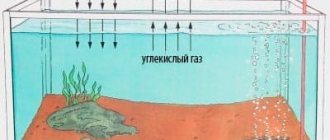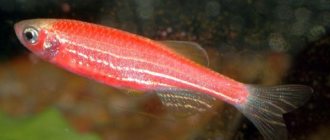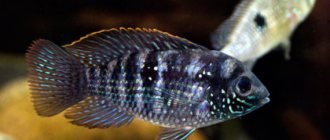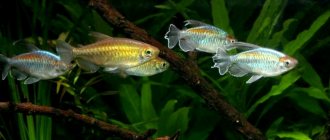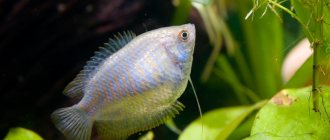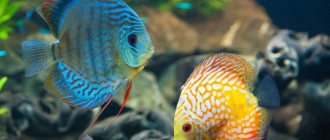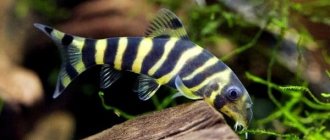Description
In nature, pygocentrus nattereri grows up to 35 cm, in an aquarium up to 25 cm, and lives in large lakes, rivers, small ponds and flooded forests. It lives in flocks of 20–30 individuals; in nature, this tactic simplifies hunting. A group of piranhas can tear their prey to pieces. They attack more often in case of danger. There are species whose average size does not exceed 15 cm.
Appearance
The body is long, laterally flattened. The jaw is convex, there are sharp large teeth. The tail is powerful. The body color is predominantly silver-gray with shimmering dots, and the belly is red. Juveniles are different from adults.
Difficult character
Piranha is dangerous to many other tankmates. Can severely bite an inattentive owner. When kept alone or in pairs in an aquarium, piranhas are timid and react to sudden movements and loud sounds. They feel more confident in a flock of 10 individuals. The group develops a hierarchy, with the dominant individual getting the best pieces of food. There are cases of cannibalism, when a weak and sick individual is eaten.
Lifespan
At home, piranhas live 10–15 years. A record number of 28 years was recorded for the red pacu.
Caring for piranhas in a home aquarium
The red-bellied piraya is capable of living in any water layer. In a container measuring at least one hundred liters, it is recommended to keep a single individual. Considering that piranha is a schooling species, for an acceptable number of fish for life you will need at least 5 pieces, then space for such a group will require a very significant displacement of at least three hundred.
As strange as this may seem, terrible killers have a very timid character, and for comfortable care, there must be secret areas in the home pond where they can hide. For these purposes, it is best to use snags or similar decoration objects, since fish are capable of aquarium vegetation destroy, then creating shelters from them is ineffective.
The main requirement for keeping piranhas is maintaining a perfectly clean water layer. Once a week, it is necessary to check the level of traces of ammonium and nitrates; using testing, replace a third of the water volume also once a week. It is necessary that a powerful external pump with a sponge be installed in the aquarium reservoir and constant measures be taken to replace the water composition.
This is all due to the fact that they are extremely littery while eating, and they feed mainly on animal food, which instantly goes bad. The filter sponge must be periodically cleaned, and similar measures must be carried out more often than in other containers. The best method to find out when such a period has begun is, of course, testing.
We invite you to read: Alben description, characteristics and instructions for use of the drug for cats
Remember that to wash sponges, you need to use aquarium liquid! The most important thing in keeping Amazonian predators is observation. Track the life of your own fish, study, delve into the essence, and after a certain period of time, owners will not need to fear for their lives. An experienced aquarist will begin to notice all problems at the initial stage.
Kinds
The most popular species are the common piranha and the red-bellied piranha. The piranha family has 16 genera and almost 100 species.
Redfin mile
The color of myloplus rubripinnis is silver, the anal fin is bright red, and the tail is translucent. There are varieties with a reddish belly and red-gold spots on the body. In an aquarium it grows up to 15 cm, in nature - up to 25 cm.
Brown pacu
The average size of a pacu is 70 cm, the body is colored in dark, gray and brown tones. The teeth are square, reminiscent of human teeth. Schooling in this species is less pronounced. Suitable for single living.
Red pacu
The red pacu is a herbivorous species, also known as the red-bellied and red-breasted pacu, the two-toothed colossoma, and the vegetarian piranha. The average size in the aquarium is 60 cm. Peaceful and shy fish. It is possible to keep them with many species of comparable size or alone.
Flag
The silvery body is laterally compressed, with a greenish tint on the back. The gill covers have a red spot, the first rays of the fins are elongated and transparent. The tail is forked. The lower jaw is massive. Predatory view.
Slender
The body of the fish is elongated. The color of the scales is silver with a black border on the tail and red on the sides.
Natterera
Natterer's piranha is named after an Australian scientist, known as "saikanga", and the Latin name is Pygocentrus nattereri, a synonym is Serrasalmus nattereri. The body is disc-shaped, reaches 35 cm in length. The color is bright, bluish, the abdomen and fins are bright red, and there is a wide blue stripe on the dark tail.
Lunar Metinnis
These piranhas have a tall body and a light silver color, with a red spot on the gill covers. Herbivorous species. Grows up to 25 cm.
Metinnis silver
The piranha is known as the silver dollar because of its resemblance to a coin. Latin name metynnis argenteus ahl. The size of the silver metinnis is small - 10–15 cm. Males have a veil anal fin, females have a straight one.
Metinnis vulgaris
The abdomen of Metinnis is silvery-white with blue and greenish tints, the fins are transparent. The body is round, strongly flattened laterally. Grows up to 15 cm. Known as mirror fish.
Sex differences
It is extremely difficult to distinguish females from males in piranhas. Visually, this can only be done through long-term observations of behavior, especially before spawning.
At this time, males are painted in the brightest colors, and the female’s abdomen becomes rounder from the eggs.
First of all, the aquarium should be in a quiet place where no one will disturb the fish. Further, the fish must be compatible (a long-established school, with a developed hierarchy).
For successful spawning, you need very clean water - a minimum of ammonia and nitrates, pH 6.5-7.5, temperature 28 C, and a large aquarium in which the couple can distinguish their own territory.
A pair ready for spawning chooses a spawning site, which it aggressively guards. The piranhas' coloration darkens and they begin to build a nest on the bottom, uprooting plants and moving rocks.
Here the female will mark the eggs, which the male will quickly fertilize. After spawning, the male will guard the eggs and attack anyone who approaches it.
The eggs are orange in color and will hatch in 2-3 days. The larva will feed from the yolk sac for another couple of days, after which it will swim.
From this moment the fry is placed in a nursery aquarium. Be careful, the male can even attack an object while protecting the fry.
Already as a fry, piranhas are very greedy for food. You need to feed them Artemia naupilia for the first days, and then add flakes, bloodworms, daphnia, etc.
The fry should be fed frequently, two to three times a day. The juveniles grow very quickly, reaching a centimeter within a month.
Share this article:
When they first heard the story about South American predatory fish, which can gnaw the carcass of an animal in a few minutes, some people are horrified, others want to admire these great and terrible creatures, and some even want to get them as pets.
Piranhas (lat. Serrasalmidae) are a large family of freshwater fish native to the waters of South America. They belong to the order Characiformes (lat. Characiformes) and are quite close relatives of the peaceful characin tetras.
In nature, piranhas are formidable predators that can easily bite even the finger of an adult. Their sharp teeth cut through flesh like a blade, and their jaws are powerful enough to bite off thick fishhooks.
In a reservoir, these dangerous fish strike fear into all inhabitants, eating almost all small animals that they can attack. The only exceptions are catfish of the genus Hoplosternum, as they help piranhas get rid of skin parasites.
Fortunately, this description is typical only for some predatory species. Many piranhas are herbivores or simply cowardly fish that pose no danger to humans.
In an aquarium, the behavior of fish is strikingly different from their wild counterparts. If wild predators gathered in large flocks are dangerous, then residents of domestic reservoirs are more timid and fearful, and in stressful situations they can even lose consciousness and fall to the bottom.
However, the danger of wild fish is exaggerated thanks to popular Hollywood films. In fact, the piranha is a very cautious creature, attacking only aquatic inhabitants and very afraid of people.
One day, ichthyologist biologist Herbert Axeldorf decided to prove how dangerous piranhas are for humans. He put a large school of fish in the pool and decided to dive into it wearing only his swimming trunks. Having received no harm, he decided to swim with a piece of bloody meat in his hand. And even then, none of the piranhas dared to approach him, although after that the predators still feasted on the meat, but only when the person was not in the water.
So where did the belief come from that piranhas are malicious killers, just waiting for the right moment to feast on human flesh? Sadly, people drown in rivers quite often, and the bodies found have the characteristic markings of piranha teeth. These fish play the role of scavengers in the ecosystem of the reservoir.
Content
Piranha is an expensive fish; most species require high-quality live food, expensive equipment and a huge aquarium. Not recommended for beginners.
Aquarium
Each individual accounts for at least 120 liters. Place a small group of 4 individuals in a 500-liter aquarium. A school of fish will require a gigantic aquarium with a volume of thousands of liters.
Water parameters
| Temperature | 22–27 degrees |
| Acidity | 6,5–7 |
| Rigidity | 4–15 dGh |
| Water movement | weak or moderate |
It is necessary to maintain a comfortable temperature in the aquarium and monitor the cleanliness of the water. The liquid should not be cold or too warm. The feeding method of predators implies rapid water pollution. Some aquarists change 30–50% of the liquid weekly, others change 10–15% of the total water volume.
Plants
Under natural conditions, the piranha biotope is full of dense vegetation. Fish in an aquarium can damage plants. Place greens that don't require a lot of light:
- Java moss;
- ferns;
- Anubias;
- blue.
- plants;
- caves;
- grottos;
- driftwood
- Filter. Large capacity will require multiple devices. Give preference to an external filter.
- Compressor. The device will provide oxygen saturation of the water.
- Thermometer and heater. Monitor the temperature in the aquarium and maintain it at a level that is comfortable for your pets. In hot weather, a cooler or ice containers placed in water will help cool the water.
Shelters
Provide plenty of hiding places to make timid predators feel comfortable. Leave room for free swimming. Piranhas love shelter in the form of:
Priming
Place sand or fine gravel at the bottom.
Siphon the soil at least once a week, thoroughly cleaning the entire bottom.
Equipment
Equip your aquarium:
Lighting
Choose moderate lighting that suits plants and fish. Too much light causes stress for piranhas. To prevent the appearance of algae, select light in the blue and red spectrum, excluding yellow. Do not allow sunlight to hit the walls of the aquarium. Place the tank at least 1.5 meters from the window. Make sure that the lamp does not overheat the liquid.
Individual characteristics
It is worth noting that rumors about the bloodthirstiness of piranhas are greatly exaggerated. Almost half of the species are herbivores (about 40 out of 80), and only 4 species, the so-called “true piranhas,” pose a threat to mammals and humans in general.
We advise you to read about how to choose a heater, external filter, substrate and background stickers for your aquarium, as well as what items are the most necessary for your aquarium.
Predators are distinguished by rapid tissue regeneration. Injured skin and fins quickly restore their functions. Cases have been recorded when a fish felt tolerably well after being left without an eye after a skirmish with a rival.
In captivity, piranhas are less aggressive than in the wild. Sometimes they are even shy, hide in cracks and holes and spend most of their time there. They are active only when feeding. In general, feeding deserves special attention.
If piranhas eat normally, they get along quite peacefully with representatives of other species, but if the food is poor, or there is not enough space in the aquarium, the fish can fight even with representatives of its own species. Moreover, the fights are brutal, predators often tear out pieces of each other’s flesh and inflict injuries.
Stress in fish can cause them to move to another aquarium; it happened that during this procedure, piranhas gnawed through the mesh of the net.
The smell of blood can make a predator go rabid. There have been recorded cases where piranhas went into a frenzy when water was added to the aquarium in which the meat was washed.
Important! Piranhas eat their wounded, weak or sick brothers.
What to feed
Feed the animals once a day. A portion of food should be eaten within a couple of minutes, then the piranha will not overeat, and the water will not be contaminated with uneaten food. Provide food commensurate with the jaws of the fish; the piranha ignores food that is too small. Piranhas differ greatly in the type of food they eat. However, occasionally predators need plant nutrition, just as vegetarians sometimes need variety in the form of live food.
Predatory
Feed carnivorous piranha species:
Once a week, give predators a fasting day. Make sure that all the inhabitants of the aquarium are well-fed, because in case of malnutrition, mutual oppression or eating of other species will begin. Serve mammalian meat as a supplement to the diet, do not abuse it.
Herbivores
Unlike carnivorous species, herbivores accept dry food. The basis of the diet are:
Feed with tubifex and bloodworms. Animal feed should not exceed 20% of the diet.
Precautionary measures
You should not place the aquarium on a low surface, especially if you have a small child or pet. You should not work in the aquarium with your bare hand if there are even the slightest wounds on it. In other cases, working with your bare hand (for example, removing leftover food) is quite acceptable, just try not to drive the fish into a corner.
Piranhas are bright and noticeable inhabitants of aquariums; it is difficult not to pay attention to them. But contrary to the reputation earned through Hollywood films, the life of fish in an aquarium depends primarily on humans. Try to remember that, despite all the aggressiveness and strength, this is, first of all, an aquarium fish that requires appropriate treatment.
Compatibility
Keep large predatory piranhas in a species aquarium. Despite the aggressive nature, it is possible to live with large catfish such as plecostomus and pterygoplichthys. Small fish will become prey for piranhas. Mix herbivorous peaceful piranhas with comparable species, for example, representatives of the characin family, giant gouramis or shark barbs. Make sure that the water parameters are suitable for different fish.
Reproduction
Piranhas can be bred in an aquarium, but creating the necessary conditions is difficult. The volume of the spawning aquarium starts from 200 liters. During the spawning period, it is necessary to monitor the purity of the water and the stability of parameters. Feed the future parents a high protein animal feed to prepare for spawning.
Sex differences
Sexual maturity occurs at 1.5 years. It is difficult to determine the sex of the fish. Closer to spawning, the males acquire an intense color, and the female’s abdomen becomes rounded from the eggs.
Spawning
Piranhas take care of their young. The fish choose a place to lay eggs and carefully guard the eggs. Depending on the species and individual characteristics of the female, there are 500–15,000 eggs in the clutch. The incubation period lasts 2–15 days. At this time, the male piranha may attack the female, so remove the female.
Fry
Hatched fry grow unevenly, sort the young by size and place larger and smaller piranhas. Starter food: Artemia nauplii, later feed:
Aquarium parameters and decorations
If you decide to have an exotic predator at home, you must meet some requirements for setting up an aquarium. Piranhas in captivity love to be in niches and shelters, so you should take care of this when setting up an aquarium.
Did you know? The officially registered longest-liver among piranhas is the red pacu, which lived for 28 years.
The volume of the aquarium should be calculated according to the following rule: per 3 cm of fish body length - 10 liters of water, but the aquarium must hold at least 150 liters. The fish is already quite large in size, and the insufficient volume of the home has a negative impact on its character. A fish can live on its own, but feels better in the company of its own kind.
These predators are voracious, leaving behind a large amount of waste products. Accordingly, you should take care of a good powerful filter; you can use several.
Vegetation
Although piranhas are predators, they also happily eat various aquatic vegetation. So all your efforts to plant a habitat for fish can go towards satisfying its gastronomic needs. Although you shouldn’t leave the aquarium without greenery either. The best solution would be to generously fill the aquarium with artificial plants. Fish eat greens especially willingly during the spawning period.
We recommend that you read about how to breed and keep plants such as Marsilia, Sagittaria, Pogostemon, Hornwort, Java moss, Cryptocoryne and Hemianthus micranthemoides in an aquarium.
Priming
Sometimes they prefer to keep piranhas in aquariums without soil, as it is more convenient to care for them. If you prefer traditional decor, ordinary sand or gravel will do just fine.
Water
The water in the aquarium must be well aerated and meet the following requirements:
- temperature - 24...26 °C;
- acidity - 6.0-7.0;
- hardness - 12-16 dH.
The water should be the cleanest, it is necessary to replace part of the water every week (sometimes twice a week), approximately 1/7 of the total volume.
Find out how to determine water hardness and the optimal water temperature in your aquarium.
Lighting
Lighting is not of fundamental importance, although there is an opinion that preference should be given to white light. The lighting rate is 0.5-0.7 W/l.
Diseases
Piranhas are hardy and rarely get sick. In poor conditions they are susceptible to:
Effective medications for most diseases can be purchased at a pet store. Before treating fish, read the instructions and determine the causes of the disease. Adjust the conditions: check the water for nitrates and other dangerous compounds, provide the piranhas with a balanced diet and make sure that the water parameters in the home aquarium are suitable for the fish.
Reviews
Owners of these interesting fish note that it is fascinating to observe the habits of predators. The intelligence and bewitching appearance of the fish are amazing. Some aquarists have encountered piranhas being aggressive towards neighbors of other species, especially in a small aquarium.



